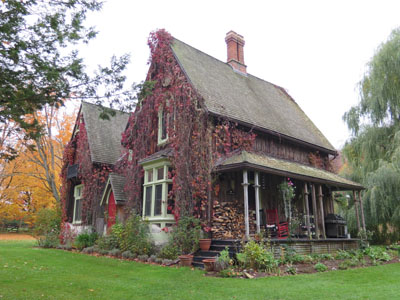Claverleigh National Historic Site of Canada
Creemore, Ontario

General view
© Parks Canada Agency / Agence Parcs Canada - Chris Johnstone
Address :
8242 Regional Road #9, Creemore, Ontario
Recognition Statute:
Historic Sites and Monuments Act (R.S.C., 1985, c. H-4)
Designation Date:
1990-11-16
Dates:
-
1871 to 1871
(Construction)
Event, Person, Organization:
-
William Forster
(Person)
-
Richard Forster
(Architect)
Other Name(s):
-
Claverleigh
(Designation Name)
Research Report Number:
Gothic Revival -1989
Plaque(s)
Built in 1871 as a parish rectory, this charming house is a significant example of a Gothic Revival villa in Victorian Canada. With its board-and-batten siding and lively elevations featuring steep gabled roofs, pointed arches, decorative chimney stacks, and varied projections, the dwelling blends harmoniously with its natural setting in accordance with 19th century ideals of the picturesque. The projecting porch, bay window, second-floor balcony, and verandah act as transitional spaces between the house and the surrounding park-like grounds, reflecting a life of rural calm and agrarian gentility.
Description of Historic Place
Claverleigh is a Gothic Revival-style villa set in extensive park-like grounds in an isolated rural setting 3.2 kilometres (2 miles) west of the Village of Creemore, Ontario.
Heritage Value
Claverleigh was designated a national historic site in 1990 as a very fine representative example of a Gothic Revival-style villa.
The heritage value of this site resides in its physical expression of the Gothic Revival-style villa in Canada.
The house was built in 1871 by William Forster as a parish rectory, to plans by his brother, British architect Richard Forster. The Gothic Revival style was considered suitably ecclesiastical in character for the style of a small rectory.
Sources: Historic Sites and Monuments Board of Canada, Minutes, June 1989, February 1990, June 1990, November 1990.
Character-Defining Elements
Key features contributing to the heritage value of this site include:
— the picturesque massing created by two one-and-a-half storey wings capped by steep roof gables joined by a small central entryway;
— the entry under a smaller, gable-roof porch and dormer window;
— the lively articulation of exterior elevations through the use of varied forms such as indentations (deep roof eaves) and projections (tall chimneys, small central roof gable, projecting porch, bay window, second floor balcony and verandah);
— the irregular articulation of its exterior surfaces through the use of textured finishing materials (shingle roof, board and batten walls);
— Gothic Revival exterior detailing including the pointed arch, label moulding framing the wooden entry door, the Gothic arches and tracery remnants of its second storey windows, the design of the bay window as an allusion to a cross);
— the Gothic Revival elements of its interior decor such as the spandrels of the wooden arches supporting its minstrel gallery;
— the building's scenic setting in expansive park-like grounds.